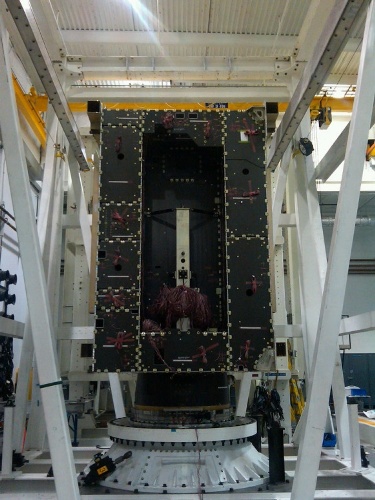Lockheed Martin delivered the core structure for the first in a series of the National Oceanic and Atmospheric Administration (NOAA)’s next-generation geostationary weather satellites to the company’s Mississippi Space and Technology Center on NASA’s Stennis Space Center where it will undergo propulsion system integration.
 The rigid external structure of the first GOES-R, which will enclose the satellite’s propulsion system and support the payloads, was designed by Lockheed Martin and manufactured by ATK Aerospace Group’s Space and Components Division, in San Diego. Photo credit: ATK
The rigid external structure of the first GOES-R, which will enclose the satellite’s propulsion system and support the payloads, was designed by Lockheed Martin and manufactured by ATK Aerospace Group’s Space and Components Division, in San Diego. Photo credit: ATK
The rigid external structure of the first Geostationary Operational Environmental Satellite–R Series (GOES-R), which will enclose the satellite’s propulsion system and support the payloads, was designed by Lockheed Martin Space Systems, in Newtown, Pa., and manufactured by ATK [NYSE: ATK] Aerospace Group’s Space and Components Division, in San Diego.
Built out of composite panels comprised of aluminum honeycomb sandwiched between graphite composite face sheets, the structure only weighs 400 pounds yet supports loads in excess of 95,000 pounds in the thrust direction and 1.8 million in-pounds in a bending moment.
For the next 11 months, the team will integrate GOES-R’s fuel tanks, lines, thermal controls and other systems within the core structure. GOES-R is based on the company’s highly reliable A2100 satellite series.
“The successful delivery of the core structure is the latest on-schedule milestone towards the planned 2015 launch of the first GOES-R series spacecraft,” said Paula Hartley, program manager for GOES-R at Lockheed Martin Space Systems Company. “Once the propulsion integration is complete, the structure will be mated to the GOES-R system module, which houses the satellite’s advanced instrumentation electronics and other critical subsystems, essentially forming the entire structure of the spacecraft.”
Data from NOAA’s GOES satellites provide accurate real-time weather forecasts and early warning products to the public and private sectors. The advanced spacecraft and instrument technology used on the GOES-R series will vastly improve forecasting quality and timeliness, generating significant benefits to the U.S. and Western Hemisphere in the areas of public safety, climate monitoring, space weather prediction, ecosystems management, commerce, and transportation.
In December 2008, NASA selected Lockheed Martin to build two next-generation GOES-R series spacecraft, with options for two additional spacecraft. In May 2012, the system passed its critical design review, a key milestone that paved the way for the team to begin the build and integration phase for the first R-series spacecraft. In addition to the spacecraft, Lockheed Martin is also designing and building the Solar Ultraviolet Imager (SUVI) and the Geostationary Lighting Mapper (GLM) instruments that will fly aboard the spacecraft.
The NOAA Satellite and Information Service funds, manages, and will operate the GOES-R series satellites. NASA oversees the acquisition and development of the GOES-R spacecraft and instruments for NOAA. The program is co-located at NASA’s Goddard Space Flight Center in Greenbelt, Md.
Headquartered in Bethesda, Md., Lockheed Martin is a global security and aerospace company that employs about 120,000 people worldwide and is principally engaged in the research, design, development, manufacture, integration and sustainment of advanced technology systems, products and services. The Corporation's net sales for 2011 were $46.5 billion.
More information about GOES-R can be found at: